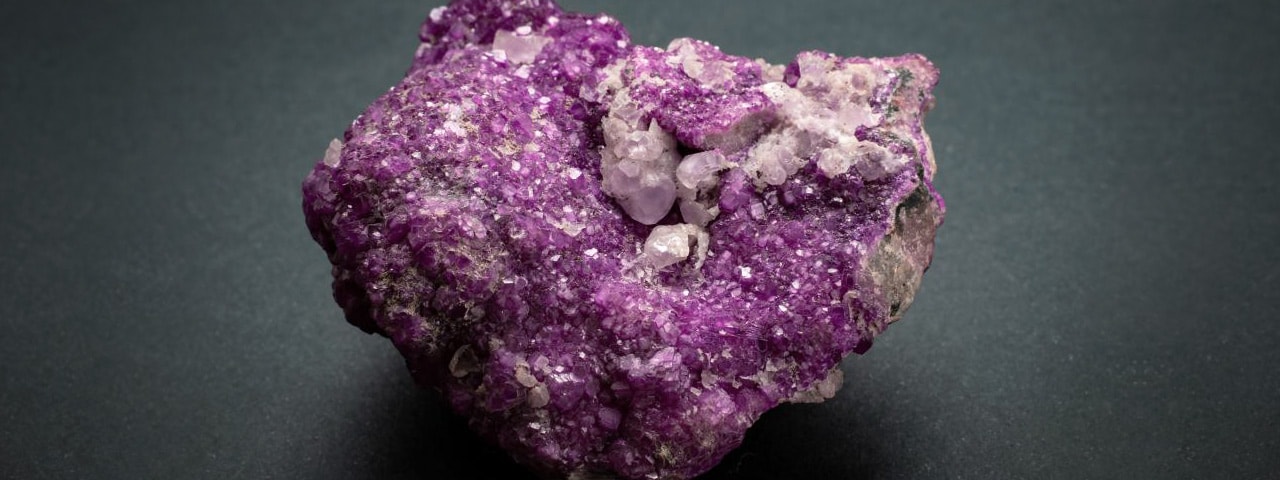Article Highlights
- Purple calcite is a calcium carbonate mineral with a unique purple hue.
- It forms in a variety of geological environments, including sedimentary, metamorphic, and igneous rocks.
- The purple color is due to the presence of trace elements or impurities in the calcite structure.
The Birth of Purple Calcite
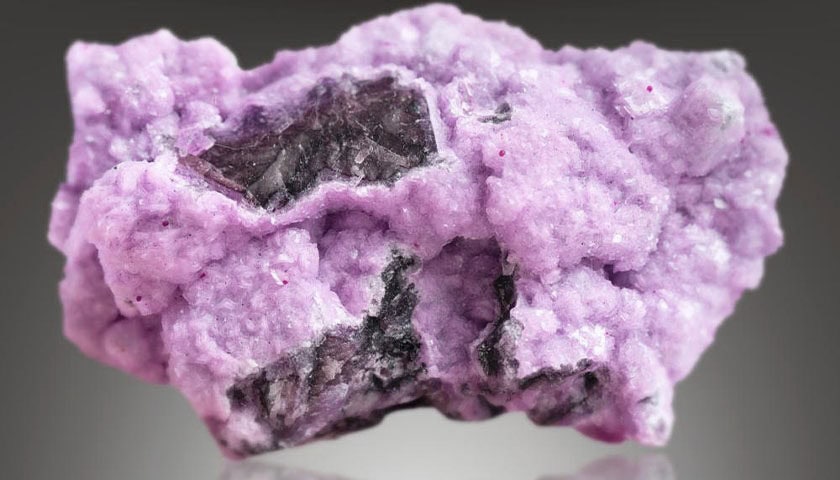
Let’s dive into the world of purple calcite, a mineral that’s as intriguing as it is beautiful. It’s a calcium carbonate mineral, which means it’s made up of calcium, carbon, and oxygen atoms. But what sets it apart is its distinctive purple hue. Now, you might be wondering, how does it get that color? Well, it’s all down to trace elements or impurities in the calcite structure. These can include elements like manganese or iron, which can give calcite a range of colors, including our focus for today, purple.
Where Does It Form?

Purple calcite can form in a variety of geological environments. It’s often found in sedimentary rocks, which are formed from the accumulation of sediments over millions of years. These sediments can include shells, plant matter, or other minerals, and when they’re compacted and cemented together, they can form rocks like limestone, which is often rich in calcite.
But that’s not the only place you’ll find it. Purple calcite can also form in metamorphic rocks, which are rocks that have been transformed by heat and pressure. And it can even form in igneous rocks, which are formed from the cooling and solidification of magma or lava. So, whether you’re exploring a limestone quarry, a metamorphic outcrop, or an igneous intrusion, keep your eyes peeled for this captivating mineral.
Physical Properties: More Than Just a Pretty Face
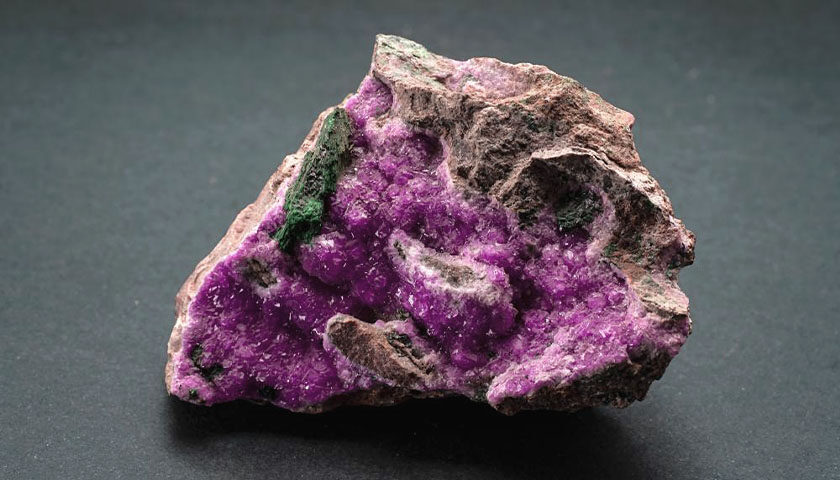
Purple calcite isn’t just beautiful; it’s also got some pretty cool physical properties. For starters, it’s got a hardness of 3 on the Mohs scale, which means it’s relatively soft. You can’t scratch it with your fingernail, but you can scratch it with a copper coin. It’s also got a specific gravity of around 2.7, which means it’s a bit heavier than you might expect for its size.
But perhaps the most fascinating thing about purple calcite is its crystal structure. It’s a trigonal mineral, which means it has a crystal structure that’s based on a three-fold axis of rotation. This gives it a unique crystal shape, with rhombohedral cleavage and a scalenohedral crystal habit. In plain English, that means it forms cool-looking crystals with slanted faces and sharp edges.
Why Should You Care?

So why should you care about purple calcite? Well, aside from its aesthetic appeal, it’s also a great way to learn about geology. By studying purple calcite, you can learn about the processes that form minerals, the environments in which they form, and the physical properties that make each mineral unique. Plus, it’s just plain cool to know that there’s a mineral out there that’s purple!
Exploring the Varieties of Purple Calcite
1. Cobaltoan Calcite
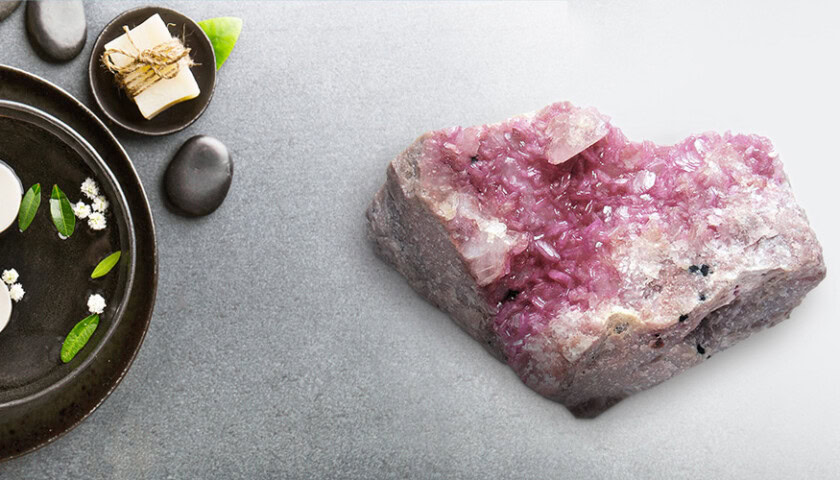
First up, let’s delve into Cobaltoan Calcite, a captivating variety of calcite. This mineral gets its name from the element cobalt, which gives it its distinctive pink to purple color. Cobaltoan Calcite is also known as Sphaerocobaltite when it forms in spherical aggregates.
Cobaltoan Calcite is a sight to behold. Its color can range from a soft, pastel pink to a vibrant, deep magenta. The color intensity depends on the amount of cobalt present in the mineral. The more cobalt, the deeper the color.
This mineral is primarily found in the Democratic Republic of Congo, where it forms in the oxidized zones of cobalt-rich ore deposits. It’s a favorite among mineral collectors for its beautiful color and crystal formations.
In the realm of crystal healing, Cobaltoan Calcite is often associated with love and compassion. It’s believed to help open the heart and encourage emotional healing.
2. Mangano Calcite
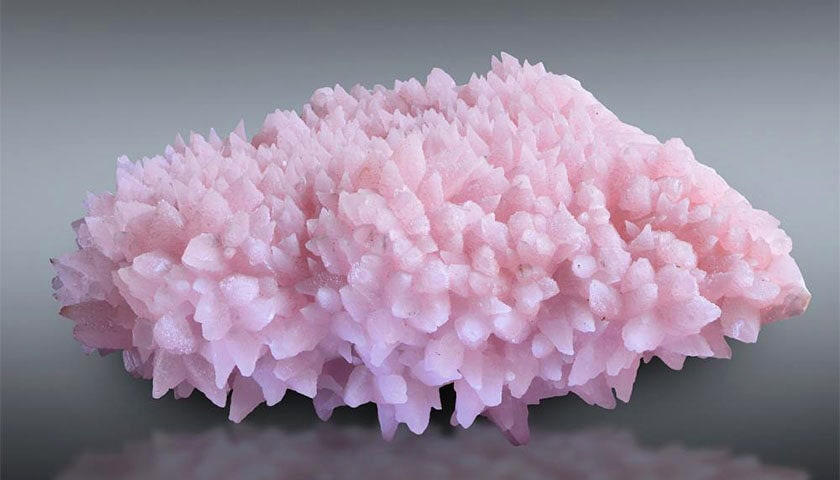
Next, we have Mangano Calcite, another beautiful variety of calcite. This mineral is named for its manganese content, which gives it a lovely pink to purple color. The presence of manganese gives Mangano Calcite a unique fluorescence, causing it to glow under ultraviolet light.
Mangano Calcite exhibits a soft, pastel pink color that’s often associated with love and gentleness. It’s a soothing and calming stone, often used in crystal healing to promote emotional healing and release fear and grief.
Mangano Calcite is found in various locations worldwide, including Peru, Brazil, and Bulgaria. It forms in rhombohedral crystal structures and can occur in massive formations.
Purple Calcite Meaning and Symbolism

The Symbolic Significance of Purple Calcite
Purple Calcite, with its enchanting hue, carries a deep symbolic significance. It’s often associated with creativity, wisdom, and spirituality. The color purple has long been linked to the divine and the mysterious, making this mineral a symbol of the mystical realm.
Purple Calcite is also seen as a stone of transition. Just as it forms under pressure and heat, it symbolizes our ability to transform challenges into opportunities. It’s a reminder that, like this stunning mineral, we too can emerge from tough times more beautiful and stronger than before.
A Beacon of Creativity and Wisdom
This captivating mineral is also a beacon of creativity. It’s believed to stimulate the imagination, encouraging innovative thinking and artistic expression. So, if you’re in a creative rut, Purple Calcite might just be the muse you need!
Moreover, Purple Calcite is associated with wisdom. It’s seen as a stone that promotes introspection, helping us delve deep into our minds to unearth profound insights.
Purple Calcite Healing Properties
- This captivating mineral is a favorite among those seeking emotional healing and spiritual enlightenment.
Emotional Benefits of Purple Calcite
Let’s delve into the emotional healing properties of Purple Calcite. This mineral, with its soothing purple hue, is like a balm for the soul. It’s believed to help balance emotions, easing anxiety and stress. Picture a wave of calm washing over you, that’s the kind of tranquility Purple Calcite is said to bring.
But it’s not just about tranquility. Purple Calcite is also linked to creativity. It’s like a spark that ignites the imagination, helping you see the world in vibrant colors and unique perspectives. It’s the perfect companion for those moments when you’re feeling stuck or uninspired.
Spiritual Benefits of Purple Calcite
Moving onto the spiritual realm, Purple Calcite is a gem. It’s often associated with spiritual growth and psychic abilities. It’s like a beacon, guiding you on your spiritual journey, helping you connect with your higher self and the universe.
Purple Calcite is also said to enhance meditation. It’s like a key that unlocks the door to deeper spiritual experiences, helping you tap into your inner wisdom and explore the mysteries of the universe.
Purple Calcite Metaphysical Properties
- It’s associated with the Third Eye Chakra, enhancing intuition and psychic abilities.
- This mineral is also linked to the element of Fire, symbolizing transformation and passion.
The Third Eye Connection
Dive into the metaphysical realm with Purple Calcite, a mineral that’s as mystical as it is beautiful. This captivating stone is often associated with the Third Eye Chakra, the energy center linked to intuition, insight, and psychic abilities. It’s like a window to the soul, helping you see beyond the physical world and into the realm of the spirit.
The Fire Element: A Symbol of Transformation
But that’s not all. Purple Calcite is also connected to the element of Fire. In many traditions, Fire symbolizes transformation, passion, and vitality. Just as fire can transform a piece of wood into ash, Purple Calcite is believed to help transform your life, burning away the old to make way for the new.
A Cosmic Connection
And let’s not forget about astrology. In the cosmic realm, Purple Calcite is often linked to the zodiac sign of Cancer. This sign is known for its emotional depth and intuition, traits that align perfectly with the properties of Purple Calcite. It’s like a cosmic ally, helping you navigate the ebb and flow of life’s tides.
A Tool for Transformation
In essence, Purple Calcite is more than just a mineral. It’s a metaphysical tool, a key that can unlock your intuition, fuel your transformation, and guide you on your cosmic journey. So why not explore the metaphysical properties of Purple Calcite? You might be surprised by the profound insights and transformations it can bring.
Purple Calcite: A Chakra and Zodiac Guide
- Purple Calcite is associated with the Third Eye Chakra, enhancing intuition and psychic abilities.
- This mineral is often linked to the zodiac sign of Cancer, aligning with its emotional depth and intuition.
Purple Calcite and Chakras
Let’s delve into the chakra connection of Purple Calcite. This captivating mineral is often associated with the Third Eye Chakra, the sixth primary chakra according to Hindu tradition. Located in the center of the forehead, the Third Eye Chakra is the seat of intuition, insight, and psychic abilities.
Purple Calcite, with its deep purple hue, is believed to resonate with this chakra’s energy. It’s like a tuning fork, helping to balance and activate the Third Eye. This can lead to enhanced intuition, greater insight, and a deeper connection to your psychic abilities. It’s like opening a door to a deeper understanding of yourself and the world around you.
Purple Calcite Zodiac Connection
In the realm of astrology, Purple Calcite is often linked to the zodiac sign of Cancer. Known for its emotional depth and intuition, Cancer aligns perfectly with the properties of Purple Calcite. This mineral can help Cancer signs tap into their intuitive abilities and navigate their emotional landscapes with greater ease.
In essence, Purple Calcite is more than just a mineral. It’s a tool for chakra balancing and astrological exploration, a companion on your journey to self-discovery and spiritual growth.
Purple Calcite: Shapes and Forms Unveiled
Purple Calcite Rough Stones
Let’s start with Purple Calcite in its most natural form: rough stones. These are chunks of Purple Calcite in their raw, unpolished state, just as they’re found in the earth. They’re a bit like hidden treasures, with their vibrant purple hues peeking out from rough, rocky exteriors.
Rough Purple Calcite stones are a favorite among mineral collectors and crystal healers alike. Collectors appreciate them for their natural beauty and geological significance, while healers value them for their potent energy. It’s believed that rough stones carry the purest form of a crystal’s energy, making them powerful tools for healing and meditation.
Purple Calcite Spheres
Next up, we have Purple Calcite spheres. These are pieces of Purple Calcite that have been shaped and polished into perfect spheres. They’re like little planets, with their smooth surfaces and swirling purple hues.
Spheres are often used in crystal healing for their ability to emit energy evenly in all directions. They’re also used in meditation, serving as a focal point to help calm the mind. With a Purple Calcite sphere, you can enjoy the beauty and energy of this mineral in a form that’s as mesmerizing as it is soothing.
Purple Calcite Hearts
Purple Calcite hearts are another popular form. These are pieces of Purple Calcite that have been carefully shaped and polished into the form of a heart. They’re like little tokens of love, radiating with the warm, nurturing energy of Purple Calcite.
Hearts are often used in crystal healing to promote love and emotional healing. They’re also wonderful gifts, symbolizing love and appreciation. With a Purple Calcite heart, you can carry the energy of this mineral close to your own heart, or share it with someone you love.
Purple Calcite Pyramids
Last but not least, we have Purple Calcite pyramids. These are pieces of Purple Calcite that have been shaped and polished into the form of a pyramid. They’re like miniature monuments, standing tall and proud with their vibrant purple hues.
Pyramids are often used in crystal healing for their ability to focus and amplify energy. They’re also used in meditation and energy work, serving as powerful tools for manifestation and transformation. With a Purple Calcite pyramid, you can harness the energy of this mineral in a form that’s as powerful as it is beautiful.
Purple Calcite vs Amethyst
When it comes to purple gemstones, Amethyst is perhaps one of the most well-known. But how does it stack up against Purple Calcite?
Physically, both Amethyst and Purple Calcite are relatively soft, with Amethyst scoring a 7 and Purple Calcite a 3 on the Mohs hardness scale. Chemically, Amethyst is a variety of quartz, while Purple Calcite is a form of calcium carbonate.
Color-wise, both gemstones showcase a range of purple hues. However, Amethyst tends to display deeper, more saturated purples, while Purple Calcite exhibits a softer, more pastel shade of purple.
In terms of origins, Amethyst is found in many locations worldwide, including Brazil, Uruguay, and Africa. Purple Calcite, on the other hand, is less common and is primarily sourced from Mexico.
Both Amethyst and Purple Calcite are used in jewelry and for their perceived healing properties. Amethyst is often associated with peace and tranquility, while Purple Calcite is linked to creativity and intuition.
As for value, Amethyst is generally more expensive due to its popularity and deeper color. It can range from $2 to $30 per carat, while Purple Calcite is more affordable, typically costing around $1 to $10 per carat.
Purple Calcite vs Purple Fluorite
Next, let’s compare Purple Calcite to Purple Fluorite. Physically, both gemstones are soft, with Purple Fluorite scoring a 4 on the Mohs hardness scale, just slightly harder than Purple Calcite.
Chemically, Purple Fluorite is a form of calcium fluoride, making it different from the calcium carbonate composition of Purple Calcite.
In terms of color, both gemstones exhibit beautiful shades of purple. However, Purple Fluorite often displays a unique phenomenon called fluorescence, where it glows under ultraviolet light.
Fluorite is found in various locations worldwide, including China, Mexico, and South Africa. Like Purple Calcite, it’s used in jewelry and for its perceived healing properties. Purple Fluorite is often associated with mental clarity and focus.
In terms of value, Purple Fluorite is relatively affordable, with prices ranging from $1 to $20 per carat, similar to Purple Calcite.
Purple Calcite vs Purple Jade
Jade is significantly harder than Purple Calcite, scoring a 6 to 7 on the Mohs hardness scale.
Chemically, Jade refers to two different minerals: nephrite and jadeite. Purple Jade is usually a form of jadeite.
Color-wise, Purple Jade displays a rich, royal purple that’s more saturated than the softer hue of Purple Calcite.
Purple Jade is primarily found in Myanmar and is highly valued in Asian cultures. It’s used in high-quality jewelry and is often associated with wisdom and nobility.
In terms of value, Purple Jade is considerably more expensive due to its rarity and cultural significance. It can range from $10 to $3,000 per carat, making it far pricier than Purple Calcite.
Purple Calcite vs Purple Agate
First up, let’s compare Purple Calcite with Purple Agate. Agate, a variety of chalcedony, is significantly harder than Purple Calcite, scoring a 7 on the Mohs hardness scale.
Purple Agate, like Purple Calcite, exhibits a beautiful range of purple hues. However, Agate often showcases unique banding patterns, giving it a distinctive appearance.
Purple Agate is found in various locations worldwide, including Brazil, Uruguay, and Mexico. It’s used in jewelry and is often associated with balance and stability in the realm of crystal healing.
In terms of value, Purple Agate is relatively affordable, with prices ranging from $1 to $20 per carat, similar to Purple Calcite.
Purple Calcite vs Charoite
Next, we have Charoite, a rare silicate mineral. Charoite is slightly harder than Purple Calcite, with a Mohs hardness of 5 to 6.
Charoite is known for its stunning lavender to deep purple color and swirling patterns. It’s primarily found in one location: the Chara River in Russia.
Charoite is used in jewelry and is often associated with transformation and spiritual insight in crystal healing.
In terms of value, due to its rarity and unique appearance, Charoite can range from $20 to $60 per carat, making it more expensive than Purple Calcite.
Purple Calcite vs Kunzite
Kunzite, a variety of the mineral spodumene, is harder than Purple Calcite, scoring a 6.5 to 7 on the Mohs hardness scale.
Kunzite exhibits a lovely pink to violet color. It’s found in various locations worldwide, including Afghanistan, Brazil, and the United States.
Kunzite is used in jewelry and is often associated with love and compassion in crystal healing.
In terms of value, Kunzite can range from $60 to $500 per carat, depending on color and quality, making it pricier than Purple Calcite.
Purple Calcite vs Lepidolite
Finally, let’s compare Purple Calcite with Lepidolite, a lithium-rich mica mineral. Lepidolite is similar in hardness to Purple Calcite, scoring a 2.5 to 3 on the Mohs hardness scale.
Lepidolite displays a range of colors from pink to purple and is found in various locations worldwide, including Brazil, Russia, and the United States.
Lepidolite is used in jewelry and is often associated with peace and tranquility in crystal healing.
In terms of value, Lepidolite is relatively affordable, with prices similar to Purple Calcite, ranging from $1 to $10 per carat.
Frequently Asked Questions About Purple Calcite
What is Purple Calcite?
Purple Calcite is a variety of calcite, a common mineral found in the Earth’s crust. It’s known for its distinctive purple color, which can range from pale lavender to deep violet.
Where is Purple Calcite found?
Purple Calcite is primarily sourced from Mexico.
What gives Purple Calcite its color?
The purple color of this calcite variety is due to the presence of trace elements or impurities in the calcite structure.
What chakra is Purple Calcite associated with?
Purple Calcite is often associated with the Third Eye Chakra.
Can Purple Calcite be submerged in water?
Yes, Purple Calcite can be submerged in water, but not for prolonged periods as it may damage the stone.
Is Purple Calcite sun safe?
Yes, Purple Calcite is sun safe, but prolonged exposure to direct sunlight may cause it to fade over time.
What is the price of Purple Calcite?
The price of Purple Calcite can range from $1 to $10 per carat, depending on its quality and size.
| Purple Calcite Physical Properties | |
|---|---|
| Crystal Structure | Trigonal |
| Mineral Class | Carbonate |
| Specific Gravity | 2.7 |
| Formula | CaCO3 |
| Hardness | 3 |
| Transparency | Transparent to opaque |
| Chemical Composition | Calcium Carbonate |
| Locations | Primarily Mexico |
| Rarity | Common |
| Can Be Submerged in Water | Yes, but not for prolonged periods |
| Sun Safe Crystal | Yes, but may fade over time |
| Special Care Instructions | Avoid harsh chemicals; clean with mild soap and water |
| Price/Carat | $1 – $10 |
| Purple Calcite Metaphysical Properties | |
|---|---|
| Chakras | Third Eye Chakra |
| Zodiac Signs | Cancer |
| Planets | Moon |
| Numerical Vibration | 8 |
| Elements | Fire |
| Symbolism | Transformation, Creativity, Wisdom |
| Birthstones | Not a traditional birthstone |
| Affirmations | “I am open to new insights and understandings.” |
| Emotional Conditions | Anxiety, Stress, Emotional Imbalance |
| Spiritual Purposes | Intuition, Psychic Abilities, Spiritual Growth |
| Crystal Combinations | Amethyst, Fluorite, Lepidolite |

